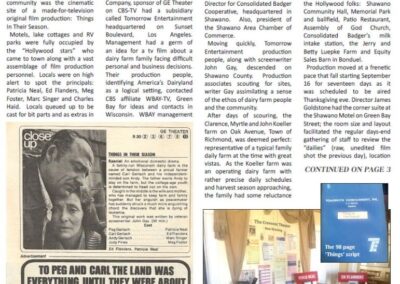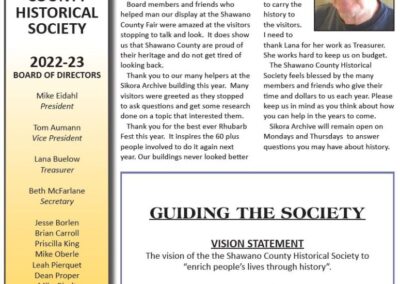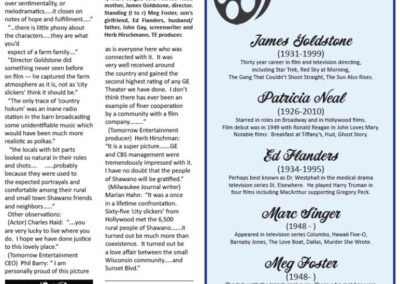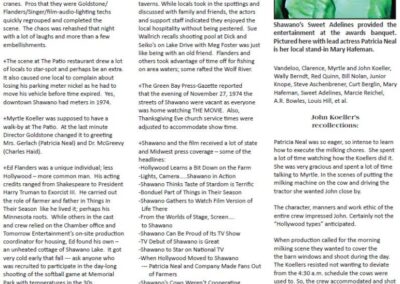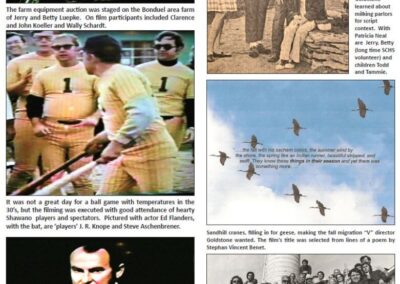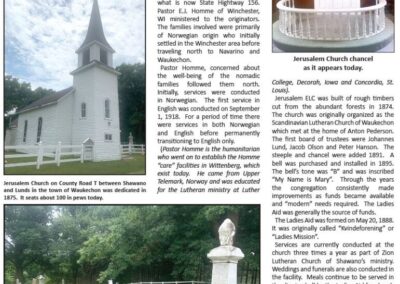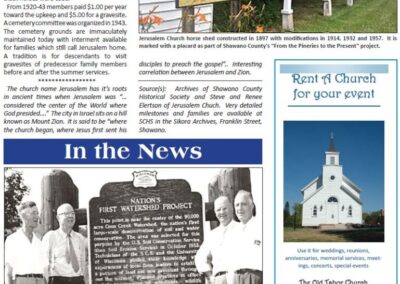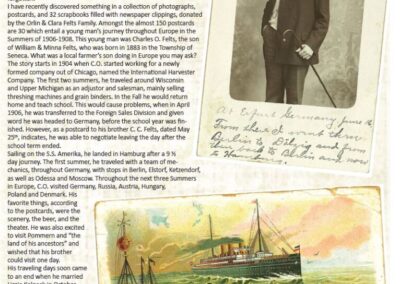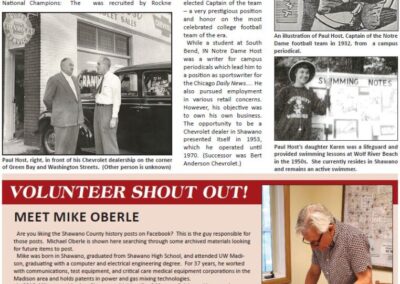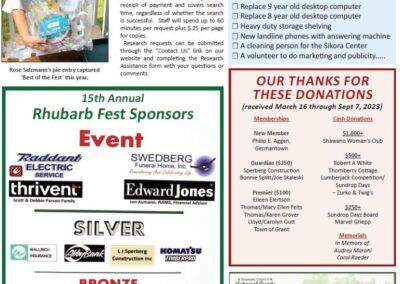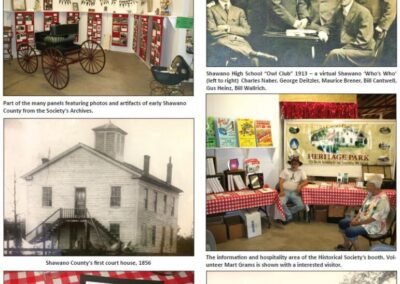Pages
Online Edition
Preservation Press Fall 2023
Shawano Meets Hollywood
In the autumn of 1974, the Shawano area was all a-buzz; star struck might be an apt term. The community was the cinematic site of a made-for-television original film production: Things In Their Season.
Motels, lake cottages and RV parks were fully occupied by the “Hollywood stars” who came to town along with a vast assemblage of film production personnel. Locals were on high alert to spot the principals: Patricia Neal, Ed Flanders, Meg Foster, Marc Singer and Charles Haid. Locals queued up to be cast for bit parts and as extras in crowd scenes.
Why Shawano? How did it happen? The General Electric Company, sponsor of GE Theater on CBS-TV had a subsidiary called Tomorrow Entertainment headquartered on Sunset Boulevard, Los Angeles. Management had a germ of an idea for a tv film about a dairy farm family facing difficult personal and business decisions. Their production people, identifying America’s Dairyland as a logical setting, contacted CBS affiliate WBAY-TV, Green Bay for ideas and contacts in Wisconsin. WBAY management suggested contacting Jim Kasten, former WBAY Farm Director and then Communications Director for Consolidated Badger Cooperative, headquartered in Shawano. Also, president of the Shawano Area Chamber of Commerce.
Moving quickly, Tomorrow Entertainment production people, along with screenwriter John Gay, descended on Shawano County. Production associates scouting for sites, writer Gay assimilating a sense of the ethos of dairy farm people and the community.
After days of scouring, the Clarence, Myrtle and John Koeller farm on Oak Avenue, Town of Richmond, was deemed perfect: representative of a typical family daily farm at the time with great vistas. As the Koeller farm was an operating dairy farm with rather precise daily schedules and harvest season approaching, the family had some reluctance to disruption before agreeing to be the key location for filming.
Other locations identified by the Hollywood folks: Shawano Community Hall, Memorial Park and ballfield, Patio Restaurant, Assembly of God Church, Consolidated Badger’s milk intake station, the Jerry and Betty Luepke Farm and Equity Sales Barn in Bonduel.
Production moved at a frenetic pace that fall starting September 16 for seventeen days as it was scheduled to be aired Thanksgiving eve. Director James Goldstone had the corner suite at the Shawano Motel on Green Bay Street; the room size and layout facilitated the regular days-end gathering of staff to review the “dailies” (raw, unedited film shot the previous day), location adjustments, script review, performance critiques and shooting schedule affirmations. In the center of the large meeting table, as always, a fresh bottle of Crown Royal.
The critics said: “….was it good? You bet it was!….”
“…….a bit of a tear-jerker, but it doesn’t drown in over sentimentality, or melodramatics…..it closes on notes of hope and fulfillment…..”
“…there is little phony about the characters…..they are what you’d expect of a farm family….”
“Director Goldstone did something never seen before on film — he captured the farm atmosphere as it is, not as ‘city slickers’ think it should be.”
“The only trace of ‘country hokum’ was an inane radio station in the barn broadcasting some unidentifiable music which would have been much more realistic as polkas.”
“the locals with bit parts looked so natural in their roles and shots…. ……probably because they were used to the expected portrayals and comfortable among their rural and small-town Shawano friends and neighbors……”
Other observations:
(Actor) Charles Haid: “….you are very lucky to live where you do. I hope we have done justice to this lovely place.”
(Tomorrow Entertainment CEO) Phil Barry: “ I am personally proud of this picture as is everyone here who was connected with it. It was very well received around the country and gained the second highest rating of any GE Theater we have done. I don’t think there has ever been an example of finer cooperation by a community with a film company………”
(Tomorrow Entertainment producer) Herb Hirschman: “It is a super picture…….GE and CBS management were tremendously impressed with it. I have no doubt that the people of Shawano will be gratified.”
(Milwaukee Journal writer) Marian Hahn: “It was a once in a lifetime confrontation. Sixty-five ‘city slickers’ from Hollywood met the 6,500 rural people of Shawano…….it turned out be much more than coexistence. It turned out be a love affair between the small Wisconsin community…..and Sunset Blvd.”
Source material for this article are available at Shawano County Historical Society, Sikora Archive and Reception Center, Franklin Street, Shawano. Copies of the film are available at Shawano County Library, Shawano. Periodically, the film is broadcast on cable and streamed on virtual networks. At the time of this printing it was not available on those sources.
The Leading Principals
James Goldstone (1931-1999) Thirty year career in film and television directing, including Star Trek, Red Sky at Morning, The Gang That Couldn’t Shoot Straight, The Sun Also Rises.
Patricia Neal (1926-2010) Starred in roles on Broadway and in Hollywood films. Film debut was in 1949 with Ronald Reagan in John Loves Mary. Notable films: Breakfast at Tiffany’s, Hud, Ghost Story.
Ed Flanders (1934-1995) Perhaps best known as Dr. Westphall in the medical drama television series St. Elsewhere. He played Harry Truman in four films including MacArthur supporting Gregory Peck.
Marc Singer (1948 – ) Appeared in television series Columbo, Hawaii Five-O, Barnaby Jones, The Love Boat, Dallas, Murder She Wrote.
Meg Foster (1948- ) The lady with the translucent eyes. Those who met her were captivated with her pale blue orbs. Films include: The Man in the Iron Mask, Ticket to Heaven, The Legend Of Sleepy Hollow.
Charles Haid (1943 – ) Best known for his portrayal of officer Andy Renko in Hill Street Blues. Also appeared in: Gunsmoke, The Choir Boys and Oliver’s Story.
Anecdotes and Observations
+Director Goldstone had a standing order that if a “V” of geese was spotted filming would be interrupted to capture the sight. A standby camera was stationed by the Koeller’s grapevines. During the dramatic scene with father (Flanders) and son (Singer) struggling to shore up a timber in the barn threatening the hay mow…..someone shouted “geese”. Filming stopped and the camera crew ran to the grape arbor. But, not geese, sandhill cranes. Pros that they were Goldstone/ Flanders/Singer/film-audio-lighting techs quickly regrouped and completed the scene. The chaos was rehashed that night with a lot of laughs and more than a few embellishments.
+The scene at The Patio restaurant drew a lot of locals to star-spot and perhaps be an extra. It also caused one local to complain about losing his parking meter nickel as he had to move his vehicle before time expired. Yes, downtown Shawano had meters in 1974.
+Myrtle Koeller was supposed to have a
walk-by at The Patio. At the last minute Director Goldstone changed it to greeting Mrs. Gerlach (Patricia Neal) and Dr. McGreevy (Charles Haid).
+Ed Flanders was a unique individual; less Hollywood – more common man. His acting credits ranged from Shakespeare to President Harry Truman to Exorcist III. He carried out the role of farmer and father in Things In Their Season like he lived it; perhaps his Minnesota roots. While others in the cast and crew relied on the Chamber office and Tomorrow Entertainment’s on-site production coordinator for housing, Ed found his own – an unheated cottage of Shawano Lake. It got very cold early that fall — ask anyone who was recruited to participate in the day-long shooting of the softball game at Memorial Park with temperatures in the 30s.
+Director Goldstone, whose mother was from Milwaukee, observed “…the film’s concept was to move from summer to fall, but we never had summer, it is winter already…..”
+Patricia Neal, who had recovered from a stroke prior to making this film, was a charming “down home” person in Shawano. She spent many hours talking with her double, Mary Hafeman and Myrtle Koeller. Though an accomplished actress, she did not have a great singing voice. When ‘ariaed’ in the Sweet Adelines song at the banquet in the Community Hall she came out a bit flat.
+As Neal’s stand-in, Mary Hafeman wore the same clothes as her everyday to set up the scenes and lighting.
+The film-making visitors were regularly seen enjoying Shawano area restaurants and taverns. While locals took in the spottings and discussed with family and friends, the actors and support staff indicated they enjoyed the local hospitality without being pestered. Sue Wallrich recalls shooting pool at Dick and Seiko’s on Lake Drive with Meg Foster was just like being with an old friend. Flanders and others took advantage of time off for fishing on area waters; some rafted the Wolf River.
+The Green Bay Press-Gazette reported that the evening of November 27, 1974 the streets of Shawano were vacant as everyone was home watching THE MOVIE. Also, Thanksgiving Eve church service times were adjusted to accommodate show time.
+Shawano and the film received a lot of state and Midwest press coverage – some of the headlines:
-Hollywood Learns a Bit Down on the Farm
-Lights, Camera…..Shawano in Action
-Shawano Thinks Taste of Stardom is Terrific
-Bonduel Part of Things in Their Season
-Shawano Gathers to Watch Film Version of Life There
-From the Worlds of Stage, Screen….to Shawano
-Shawano Can Be Proud of Its TV Show
-TV Debut of Shawano is Great
-Shawano to Star on National TV
-When Hollywood Moved to Shawano—Patricia Neal and Company Made Fans Out of Farmers
-Shawano’s Cows Weren’t Cooperating
-The Director Who Came to Shawano—He’s Expected to be All-Knowing
-On Location with a Hollywood Film Crew
-Consolidated Badger People Involved in TV Drama
+At the risk of omitting someone, a partial list of locals who facilitated the filming and/or appeared on screen: Jim Esch, Jim Cerveny, Ron Timm, Larry Evans, John McCormick, Pat Kasten, Wally Schardt, Betty and Jerry Luepke, Rick and Jim Schoenhofen, John Rusch, Geri Vandeloo, Clarence, Myrtle and John Koeller, Wally Berndt, Red Quinn, Bill Nolan, Junior Knope, Steve Aschenbrener, Curt Berglin, Mary Hafeman, Sweet Adelines, Marcie Reichel, A.R. Bowles, Louis Hill, et al.
John Koeller’s recollections:
Patricia Neal was so eager, so intense to learn how to execute the milking chores. She spent a lot of time watching how the Koellers did it. She was very gracious and spent a lot of time talking to Myrtle. In the scenes of putting the milking machine on the cow and driving the tractor she wanted John close by.
The character, manners and work ethic of the entire crew impressed John. Certainly not the “Hollywood types” anticipated.
When production called for the morning milking scene they wanted to cover the
the barn windows and shoot during the day. The Koellers resisted not wanting to deviate from the 4:30 a.m. schedule the cows were used to. So, the crew accommodated and shot the scene at that early hour.
The calving scene was a dramatic point of the film. It also had it’s behind the scenes drama. The cow, Bessie, needed to simulate death in calving requiring tranquilizing. Koeller’s veterinarian Robert Fischer, DVM, was initially reluctant to facilitate and be involved in any way; he eventually capitulated. (Bessie required make-up artist attention – blackening around the eyes and fake tears).
*****************
PRESIDENT’S MESSAGE – MIKE EIDAHL
2023 seems to have flown by quickly. Soon Fall will be upon us and Heritage Park will be closed for this year. Thank you to all our volunteers who helped guide tours, worked at an event, or just helped to keep the park looking so nice this year.
Board members and friends who helped man our display at the Shawano County Fair were amazed at the visitors stopping to talk and look. It does show us that Shawano County are proud of their heritage and do not get tired of looking back.
Thank you to our many helpers at the Sikora Archive building this year. Many visitors were greeted as they stopped to ask questions and get some research done on a topic that interested them.
Thank you for the best ever, Rhubarb Fest this year. It inspires the 60 plus people involved to do it again next year. Our buildings never looked better thanks to Jesse and our crew of buildings and grounds. Our docents worked hard to carry the history to the visitors. I need to thank Lana for her work as Treasurer. She works hard to keep us on budget.
The Shawano County Historical Society feels blessed by the many members and friends who give their time and dollars to us each year. Please keep us in mind as you think about how you can help in the years to come.
Sikora Archive will remain open on Mondays and Thursdays to answer questions you may have about history.
****************
GUIDING THE SOCIETY
VISION STATEMENT
The vision of the the Shawano County Historical Society to “enrich people’s lives through history.”
MISSION STATEMENT
The mission of the the Shawano County Historical Society is to “preserve the culture and history or Shawano County by creating a vibrant learning experience and serving as a resource for current and future generations”.
*****************
From Horse shed to Fellowship Hall
While driving on Shawano County Road T between Shawano and Lunds an unusual building catches the traveler’s eye. Across the road is the Jerusalem Evangelical Church and Cemetery. The long, narrow building appears to be part farm shed, part enclosed quarters. In fact, it was built as a horse shed in 1915 at a cost of $252.00, paid for by the Jerusalem Ladies Aid. It sits on a piece of 30 x 160 feet land purchased from Ole Cornelius for $50.00. In 1932 part of the shed was partitioned off for a dining hall at a cost of $231.00, again a project funded by the Ladies Aid.
The parish roots go back to December 7, 1869 when twenty-three “guests….. were present at the Lord’s Table…..” at the home of Martinus and Bertha Anderson located on what is now State Hightway 156. Pastor E.J. Homme of Winchester, WI ministered to the originators. The families involved were primarily of Norwegian origin who initially settled in the Winchester area before traveling north to Navarino and Waukechon.
Pastor Homme, concerned about the well-being of the nomadic families followed them north. Initially, services were conducted in Norwegian. The first service in English was conducted on September 1, 1918. For a period of time there were services in both Norwegian and English before permanently transitioning to English only.
(Pastor Homme is the humanitarian who went on to establish the Homme “care” facilities in Wittenberg, which exist today. He came from Upper Telemark, Norway and was educated for the Lutheran ministry at Luther College, Decorah, Iowa and Conordia, St. Louis).
Jerusalem ELC was built of rough timbers cut from the abundant forests in 1874. The church was originally organized as the Scandinavian Lutheran Church of Waukechon which met at the home of Anton Pederson. The first board of trustees were Johannes Lund, Jacob Olson and Peter Hanson. The steeple and chancel were added 1891. A bell was purchased and installed in 1895. The bell’s tone was “B” and was inscribed “My Name is Mary”. Through the years the congregation consistently made improvements as funds became available and “modern” needs required. The Ladies Aid was generally the source of funds.
The Ladies Aid was formed on May 20, 1888. It was originally called “Kvindeforening” or “Ladies Mission”.
Services are currently conducted at the church three times a year as part of Zion Lutheran Church of Shawano’s ministry. Weddings and funerals are also conducted in the facility. Meals continue to be served in the dinning hall by the Ladies Aid for church rites and after the summertime services. Prior to 1968, the pastors of Zion conducted regular services at Jerusalem. However, the demands of serving a rapidly growing Zion congregation and building the church on Union Street, Shawano meant the Zion pastor could no longer adequately serve Jerusalem. At that time, Spring of 1968, most Jerusalem members joined Zion.
Jerusalem Lutheran Cemetery
In 1902, Jerusalem’s Board of Trustees purchased one acre of land from Peter and Thrine Hanson for $5.00 to formally enshrine a church cemetery. Prior to that some parishoners had been buried on the land adjacent to the church. In 1903, the congregation voted to buy a rope to lower the caskets at burial. Prior to that lines from the harnesses of Ole R. Nelson’s team of two black horses were used.
From 1920-43 members paid $1.00 per year toward the upkeep and $5.00 for a gravesite. A cemetery committee was organized in 1943. The cemetery grounds are immaculately maintained today with interment available for families which still call Jerusalem home. A tradition is for descendants to visit gravesites of predecessor family members before and after the summer services.
The church name Jerusalem has its roots in ancient times when Jerusalem was “… considered the center of the World where God presided….” The city in Israel sits on a hill known as Mount Zion. It is said to be “where the church began, where Jesus first sent his disciples to preach the gospel”.. Interesting correlation between Jerusalem and Zion.
Source(s): Archives of Shawano County Historical Society and Steve and Renee Elertson of Jerusalem Chuch. Very detailed milestones and families are available at SCHS in the Sikora Archives, Franklin Street, Shawano.
*****************
FROM THE ARCHIVES
By Jesse Borlan, Curator
The Summer has flown by, and we have been extremely busy at the Historical Society processing an influx of new collections, among other things. Part of the process is sorting and organizing, especially collections with archival material and photographs. While everything we accept is important in preserving Shawano County’s history, some items are not necessarily thrilling. However, sometimes you stumble across a hidden gem or something interesting about an individual that has been forgotten.
I have recently discovered something in a collection of photographs, postcards, and 32 scrapbooks filled with newspaper clippings, donated by the Orlin & Clara Felts Family. Amongst the almost 150 postcards are 30 which entail a young man’s journey throughout Europe in the Summers of 1906-1908. This young man was Charles O. Felts, the son of William & Minna Felts, who was born in 1883 in the Township of Seneca. What was a local farmer’s son doing in Europe you may ask?
The story starts in 1904 when C.O. started working for a newly formed company out of Chicago, named the International Harvester Company. The first two summers, he traveled around Wisconsin and Upper Michigan as an adjustor and salesman, mainly selling threshing machines and grain binders. In the Fall he would return home and teach school. This would cause problems, when in April 1906, he was transferred to the Foreign Sales Division and given word he was headed to Germany, before the school year was finished. However, as a postcard to his brother C. C. Felts, dated May 25th, indicates, he was able to negotiate leaving the day after the school term ended.
Sailing on the S.S. Amerika, he landed in Hamburg after a 9 ½ day journey. The first summer, he traveled with a team of mechanics, throughout Germany, with stops in Berlin, Elstorf, Ketzendorf, as well as Odessa and Moscow. Throughout the next three Summers in Europe, C.O. visited Germany, Russia, Austria, Hungary, Poland and Denmark. His favorite things, according to the postcards, were the scenery, the beer, and the theater. He was also excited to visit Pommern and “the land of his ancestors” and wished that his brother could visit one day.
His traveling days soon came to an end when he married Lizzie Kolpack in October 1908. He settled down in Tilleda, where he owned and operated a store, as well as serving as postmaster. He was also heavily involved in local organizations and the Leopolis State Bank. Charles, like many of his relatives, was highly regarded in the community and many were saddened when he passed away in 1951.
*****************
Volunteer Shout Out
Are you liking the Shawano County history posts on Facebook? This is the guy responsible for those posts. Michael Oberle is shown here searching through some archived materials looking for future items to post.
Mike was born in Shawano, graduated from Shawano High School, and attended UW Madison, graduating with a computer and electrical engineering degree. For 37 years, he worked with communications, test equipment, and critical care medical equipment corporations in the Madison area and holds patents in power and gas mixing technologies.
In 2016, Mike moved back to Shawano with his wife of 44 years, Sylvia, and began volunteering at the SCHS because he is keenly interested in local history. He learned the process of accessioning and cataloging articles, developed procedures, and advanced the Society’s Facebook page participation through publication of weekly historical posts, as well as being responsible for the content on the SCHS Website. He was elected to a three-year term on the Society’s Board of Directors in 2022.
Also active in the community, Mike is mentoring a Leadership Shawano County team that is developing a Shawano Has History plaque project to identify historic county buildings that will display bronze plaques with information about the building. This led him to update the SCHS website and logo for a more contemporary audience and interactive users. The SCHS website will not only provide a place to link QR codes for more information about buildings but also the capability for online search of our collections. Mike is spearheading it all! We wouldn’t be where we are without his efforts.
*****************
Football Royalty: Chevy Dealer
It’s Fall. It’s football season. Think football – think college football – likely, Knute Rockne and Norte Dame football will eventually come to mind; enter the conversation.
Shawano has a unique connection to Coach Rockne and the 1930 college football National Champions: The Fighting Irish. Paul Host was on that team. Paul Host owned and operated Paul Host Chevrolet on the corner of Green Bay and Washington streets.
Paul was a gifted multi-sport athlete at LaCrosse, WI Central High School, and high achieving student. He was recruited by Rockne to play football at Norte Dame. At 5’11” and 165 pounds he was small by today’s requisite football player standards. He played end on both offense and defense which was normal at the time; putting the best athletes on the field. His senior year, 1932, he was elected Captain of the team – a very prestigious position and honor on the most celebrated college football team of the era.
While a student at South Bend, IN Notre Dame Host was a writer for campus periodicals which lead him to a position as sportswriter for the Chicago Daily News…. He also pursued employment in various retail concerns. However, his objective was to own his own business. The opportunity to be a Chevrolet dealer in Shawano presented itself in 1953, which he operated until 1970. (Successor was Bert Anderson Chevrolet.)
*****************
MEMBERSHIP HAS BENEFITS!
If you aren’t already a member, consider joining now. Membership donations are an important part of generating operating funds. Join now through our website www.shawanohistory.com “Membership” link.
A change is coming October 1st. A base fee of $20.00 will apply for non-members requesting Research Assistance. Research will begin after receipt of payment and covers search time, regardless of whether the search is successful. Staff will spend up to 60 minutes per request plus $.25 per page for copies.
Research requests can be submitted through the “Contact Us” link on our website and completing the Research Assistance form with your questions or comments.
*****************
History at the County Fair
Each year Shawano County Historical Society curator Jesse Borlen and volunteers erect a display and information booth in the Farmers Exhibitor Building. The booth is
Attended by Society volunteers, this year coordinated by Mike Rindt. This year’s emphasis was on activities of county citizens at the turn of the 20th Century.
*****************
WAYS YOU CAN HELP US FINANCIALLY
- Membership* Consider upgrading to a higher membership level when you receive your annual renewal information by mail. Encourage friends and family to join.
- Cash Donations* Monetary donations help us maintain historical documents and artifacts, adhere to professional museum and archival standards, maintain museum buildings, and pay operating expenses.
- In-kind Donations. Donations of goods and services allow us to keep operating expenses low and use the funds we raise for our programs and historic preservation.
- Other Ways to Donate
- Utilize employer donation matching programs to benefit SCHS, such as Benevity Causes (Prudential), Thrivent Your Cause, Prevea Circle of Giving, ThedaCare community volunteer program.
- Designate SCHS to receive merchant charity donations, such as Amazon Smile and Thrivent Choice Dollars.
- Memorials on behalf of a missed loved one
- Community Foundation grants
- A gift of appreciated stocks, bonds, or real estate to the SCHS eliminates federal taxes on capital gains.
- Use your required minimum distribution from your IRA as a tax free gift.
- Make the SCHS a beneficiary of a percentage of your IRA, 401k, annuity, will, or trust.
Membership and Donations available online at www.shawanohistory.org

